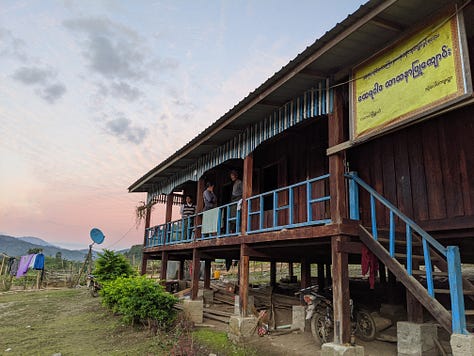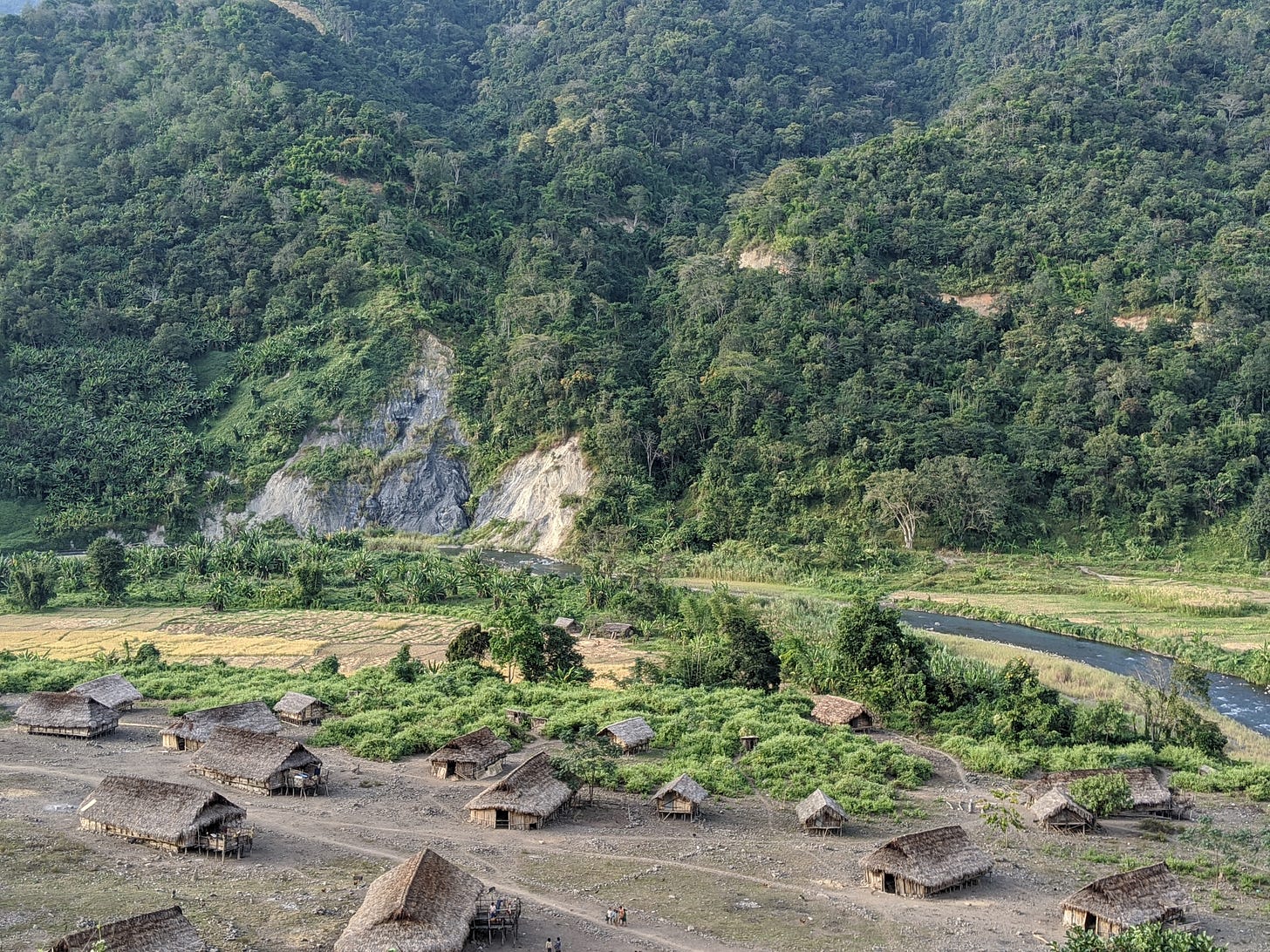Opium, Celine Dion and Wuthering Heights in the Jungles of Northern Myanmar
A Burmese teacher's lesson in optimism to take you into 2025
Stories are capricious things. I’d planned to write about Georgia this month, but it seems that story wasn’t ready to be told. I sat at my desk for much of yesterday, tripping over words, deleting sentences, bedevilled by perfectionism. It felt like trying to dig a hole and repeatedly hitting rocks. And then last night, as I was drifting off to sleep, I thought of Zarni, a teacher I once met in the northern reaches of Myanmar. I remembered his laugh, his optimism, his passion for Celine Dion. And at once I knew I wanted to tell you about him instead. I’ll come back to Georgia another time.
In late 2019, after a month of motorcycling solo across the Indian state of Nagaland, I travelled up the Chindwin river to Myanmar’s Naga Self-Administered Zone, a jagged seam of mountains marking the Indo-Myanmar border. Home to 120,000 Naga – a Tibeto-Burman people made up of an estimated seventy tribes – the region was difficult to reach, its jungles thick with Naga rebel camps. As one Burmese Naga told me: “Only good friends or serious enemies can reach our villages.” The remoteness went some way to explaining why - while much has been written of the Naga tribes in India - Myanmar’s Naga are rarely mentioned.



A few days north of Lahe, the only town in the region, I reached the Lainong Naga village of Ann Paw where I spent the evening with a hunter called Anu, sitting cross-legged beside the fire as the last shards of daylight sliced through the hut’s bamboo walls. Anu, his hands black with grease and opium, cleaned his rifle beside the fire, while his wife, her facial tattoos just visible in the gloom, butchered the last of a Sambar deer. Its skull gleamed white on the wall behind me, next to those of wild boar, monkey, bear and clouded leopard. “I have to hunt to feed my family and fellow villagers,” Anu told me. “Without it we can’t survive.” Beside us, a bony black dog nosed through the ashes in search of scraps.
Not long after I arrived, the door creaked open and a young man burst in, his green Fila tracksuit top and broad smile bright against the hut’s smoky interior. “Hello! My name is Zarni – I’m the village English teacher!” he exclaimed, his face ablaze with the excitement of meeting a real Brit.
Gathering his longyi, he sat on a stool beside me and launched into a torrent of Burmese and English, his conversation punctuated by infectious bouts of laughter.
“Ah, Mr Ant!” he said, when I introduced myself. “Friendly Ant!”
Zarni was 25 and came from Monywa, a town about 400-miles south of here on the banks of the Chindwin river. But as is common for newly-qualified teachers in Myanmar, he’d been posted to this remote village, where he’d spend the next two years. “We have no choice,” he shrugged.
Beautiful though these mountains are, it's not an easy place to live, or to teach. The village’s sixty thatched huts are scattered along a riverbank between walls of jungle-drenched mountains and the Lainong, one of Myanmar’s ten Naga tribes, barely speak any Burmese. There was no electricity, no proper road, no shop, no doctor, no sanitation – not even any mobile phone signal. Zarni earned 250,000 Kyat a month, around £140, a third of which he had to spend on taking a motorbike taxi to Lahe to collect his government salary. During his two-year posting he’d be lucky to see his family twice, since he couldn’t afford the three-day boat trip home.
For food and lodging, he relied on the kindness of the Lainong – people who barely produced enough to feed themselves. He lived in the village’s simple wooden monastery, where he shared the floor with the lone monk, the village’s families taking it in turn to provide his food.
“I’m a bit like a monk,” he giggled. “I have to get my food from my pupils, like a monk collects alms.”
As we spoke, Anu the hunter, drew heavily on his opium pipe, its gurgles mixing with the twilight clatter of insects. Meanwhile Zarni and I tucked into a bottle of lahu, maize whisky, my new friend’s volubility increasing with every glug.
“My dream is to visit London and see Tottenham Hotspurs play. But my salary is so bad!” he laughed. If this was the case, why was he a teacher? I asked. “It’s my hobby, I enjoy! I happy person!” he replied, speaking with the speed and energy of a chat show host.
Spurs wasn’t the only thing Zarni adored about England. “I love Wuthering Heights!” he declared. “Mr Heathcliff is so intellectual, proud, eager and strong!” I admitted, rather shamefully, that I hadn’t read Wuthering Heights. (I know, I know), at which Zarni looked at me, eyes wide, as if I’d committed a cardinal sin.
He then moved on to another British hero. “I love Mr Wellington!” Seeing my puzzlement, he added: “You know, the Battle of Waterloo!”
But what Zarni really, really loved was the film Titanic. He’d seen it fourteen times, and often whiled away the evenings singing ‘My heart must go on’ with a karaoke set that he and the monk had rigged up to a solar-powered car battery. The image of this had me nearly choking on my whisky, and led to a good half hour of us singing Celine Dion. Just recalling that evening still makes me laugh out loud.
The following morning, after a rather sleepless night on the floor of the monastery, I visited Zarni’s school, a one-roomed wooden building on the edge of the village. It was break time when I arrived and a ragged bunch of children were playing tug of war outside, their bare feet kicking up dust.
Zarni, his usual buoyant self, gathered the children together for a photograph, and they all posed shyly. I wondered if they realised how lucky they were to have someone like Zarni in their lives.
As I left, I hugged Zarni and told him what a gift his happiness was, how there were people in the world who had everything – money, choice, big houses, expensive cars – but would never be as happy as he was. How fortunate I was to have met him.
BEFORE YOU GO…
If you’ve liked this story, please do leave a comment or press the little like button below - it helps get more eyeballs on my posts. Thank you!
If you want to kick off the New Year with a good writing habit, why not write with me for 10 mornings in January, starting on Monday 6th. Details here.
You’ll of course know that things in Myanmar have deteriorated since my 2019 visit. To find out more, watch my friend Katie Arnold’s film Myanmar: The Forgotten Revolution here.
Thanks for your time, your attention and your comments and emails. See you next month! Until then HAPPY NEW YEAR. May it be year of stubborn optimism, in spite of all that out there.
Love, Ants xx
Keep reading with a 7-day free trial
Subscribe to Under the Hawthorn Tree with Antonia Bolingbroke-Kent to keep reading this post and get 7 days of free access to the full post archives.






